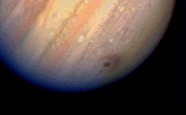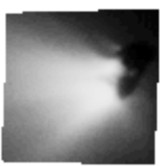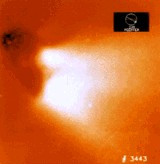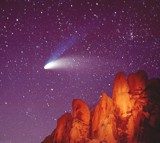Comet Impacts
 Time-lapse of Comet P/Shoemaker-Levy 9 (210 kb)
Time-lapse of Comet P/Shoemaker-Levy 9 (210 kb)
This set of images, taken by the Hubble Space Telescope, shows the evolution of the four brightest fragments of P/Shoemaker-Levy 9, from July 1993 to March 1994. The comet had previously broken up near Jupiter, and then after these images were taken collided directly with it, on 1994 July 16. Courtesy, NASA.
Hubble Image of 21 SL-9 Fragments (74 kb)
 This is the last Hubble Space Telescope image of the comet Shoemaker-Levy 9 before it impacted Jupiter. Twenty-one fragments of the comet were counted stretching across 1.1 million kilometres of space. Courtesy, NASA.
This is the last Hubble Space Telescope image of the comet Shoemaker-Levy 9 before it impacted Jupiter. Twenty-one fragments of the comet were counted stretching across 1.1 million kilometres of space. Courtesy, NASA.
 Image of comet SL-9 impacting Jupiter (16 kb)
Image of comet SL-9 impacting Jupiter (16 kb)
This is an amazing image that was taken by the spacecraft Galileo as the comet Shoemaker-Levy 9 (fragment W) was impacting Jupiter on 1994 July 22. Courtesy, NASA.
 SL-9 Impact Scar on Jupiter (154 kb)
SL-9 Impact Scar on Jupiter (154 kb)
This is an historic image of an actual impact event on a planet in our solar system. The incredible optics of the Hubble Space Telescope shows clearly the black scar made by the impact of Shoemaker-Levy 9, fragment G, on Jupiter. Courtesy, NASA.
Spacecraft Images
 Giotto Image of Halley's Comet (60 kb)
Giotto Image of Halley's Comet (60 kb)
Taken by the spacecraft Giotto, about five minutes before closest approach on 1986 March 14, this image clearly shows the dark nucleus of Comet Halley, and the powerful jets of material streaming off it. Courtesy, NASA.
 False-Color Image of Halley's Comet (297 kb)
False-Color Image of Halley's Comet (297 kb)
This false-color image was taken at a distance of just 6500 kilometres from the nucleus of Comet Halley and only 95 seconds before closest approach. Courtesy, NASA.
Images from Earth
 Image of Comet Hale-Bopp in March 1997 (118 kb)
Image of Comet Hale-Bopp in March 1997 (118 kb)
Comet Hale-Bopp was one of the brightest comets in history and set an unaided-eye visibility record of 19 months, shattering the previous record of 9 months held by the Great Comet of 1811. This image was taken from Red Canyon Park, California by Loke Kun Tan. Courtesy, NASA.
 Image of Comet Hale-Bopp in April 1997 (181 kb)
Image of Comet Hale-Bopp in April 1997 (181 kb)
Comet Hale-Bopp was one of the most amazing comets of the 20th century and the brightest since Comet West in 1976. It was discovered independently by Alan Hale in New Mexico and Thomas Bopp in Arizona. This image was taken by Wally Pacholka from Joshua Tree National Park in California. Courtesy, NASA.
